A tip plasty is a cosmetic surgical procedure that is used to reshape the tip of the nose. It is often performed to correct a bulbous or droopy tip, or to refine the shape of the nose for aesthetic purposes. In this article, we will discuss the procedure for a tip plasty and the costs associated with the procedure.
What is a Tip Plasty?
A tip plasty is a surgical procedure that is used to reshape the tip of the nose. It is a relatively minor procedure that is typically performed on an outpatient basis under local anesthesia. The goal of a tip plasty is to refine the shape of the nose and create a more aesthetically pleasing appearance.
During a tip plasty, the surgeon will make small incisions in the skin between the nostrils and the tip of the nose. Through these incisions, the surgeon will reshape the cartilage and tissue in the tip of the nose to achieve the desired shape.
Costs Associated with a Tip Plasty
The cost of a tip plasty can vary depending on a number of factors, including the surgeon’s fees, the location of the procedure, and the complexity of the procedure. In general, the cost of a tip plasty can range from $3,000 to $8,000.
The cost of the procedure may include fees for the surgeon, anesthesia, and the facility where the procedure is performed. In some cases, additional costs may be incurred for pre-operative tests, post-operative care, and medications.
It is important to note that the cost of the procedure may not be covered by insurance if it is deemed to be a cosmetic procedure. However, if the procedure is deemed to be medically necessary, insurance may cover some or all of the costs.
Factors That Affect the Cost of a Tip Plasty
Surgeon’s fees: The fees charged by the surgeon can vary depending on their level of experience and expertise.
Location of the procedure: The location of the procedure can also affect the cost. Procedures performed in major metropolitan areas may be more expensive than those performed in smaller cities or towns.
Complexity of the procedure: The complexity of the procedure can also affect the cost. More complex procedures may require more time and skill, which can increase the cost.
Anesthesia fees: The type of anesthesia used during the procedure can also affect the cost. General anesthesia is typically more expensive than local anesthesia.
Facility fees: The fees charged by the facility where the procedure is performed can also vary depending on the location and level of care provided.
Additional Costs Associated with a Tip Plasty
In addition to the costs associated with the procedure itself, there may be additional costs associated with the recovery process. These costs may include:
Medications: Pain medications and antibiotics may be prescribed to help manage pain and prevent infection.
Follow-up appointments: Follow-up appointments may be necessary to monitor the healing process and remove any sutures or dressings.
Imaging tests: Imaging tests, such as X-rays or CT scans, may be necessary to evaluate the extent of the injury and ensure proper healing.
Time off work: Depending on the nature of the patient’s job, they may need to take time off work to recover from the procedure.
Insurance Coverage for a Tip Plasty
Whether or not insurance will cover the cost of a tip plasty depends on a number of factors, including the reason for the procedure. If the procedure is deemed to be medically necessary, insurance may cover some or all of the costs. However, if the procedure is deemed to be cosmetic, insurance may not cover any of the costs.
It is important to check with your insurance provider to determine what is covered and what is not covered before undergoing any medical procedure.
Choosing a Surgeon for a Tip Plasty
When choosing a surgeon for a tip plasty, it is important to find a qualified and experienced surgeon who specializes in facial plastic surgery. The surgeon should be board-certified and have a good reputation in the field.
It is also important to schedule a consultation with the surgeon before undergoing the procedure. During the consultation, the surgeon will evaluate the patient’s nose and discuss the desired outcome of the procedure. The surgeon will also explain the risks and benefits of the procedure and answer any questions that the patient may have.
Recovery from a Tip Plasty
Recovery from a tip plasty typically takes one to two weeks. During this time, the patient may experience swelling, bruising, and discomfort. Pain medications may be prescribed to help manage pain and discomfort.
The patient will need to avoid strenuous activities and exercise for several weeks after the procedure. They should also avoid blowing their nose for at least two weeks after the procedure.
Follow-up appointments will be necessary to monitor the healing process and remove any sutures or dressings. The surgeon will provide specific instructions for post-operative care and recovery.
Conclusion
A tip plasty is a cosmetic surgical procedure that is used to reshape the tip of the nose. The cost of the procedure can vary depending on a number of factors, including the surgeon’s fees, the location of the procedure, and the complexity of the procedure. If you are considering a tip plasty, it is important to consult with a qualified surgeon to discuss the procedure and the costs associated with it. With proper care and treatment, you can achieve the desired shape and appearance of your nose through a tip plasty.


